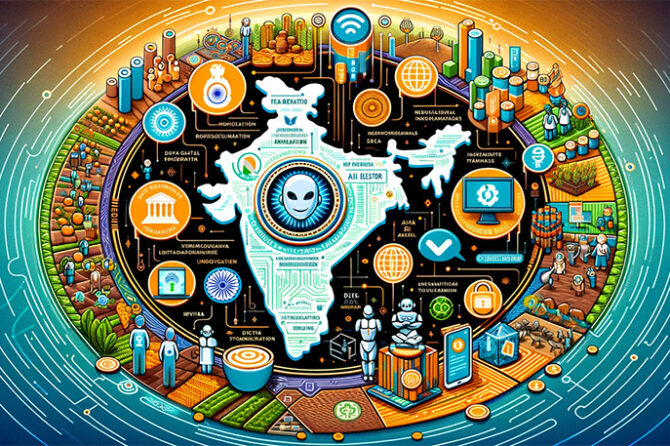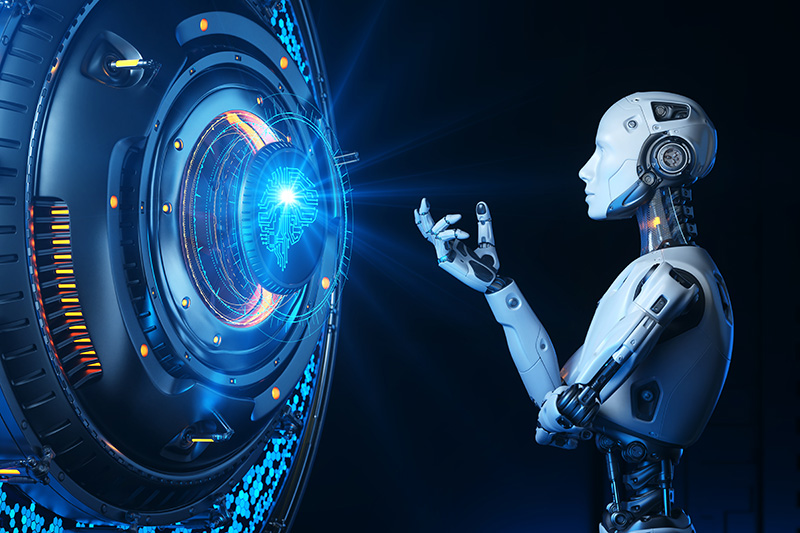
Nandan Nilekani and Tanuj Bhojwani’s article, “Unlocking India’s Potential with AI”, paints a promising picture of India’s potential to become the world’s leading user of AI by the end of this decade. This is not just hype – their argument rests on three strong pillars: urgent need, robust infrastructure, and a thriving innovation ecosystem. Let’s delve deeper into these pillars with data, statistics, and references to understand the potential and the path ahead.
1. Urgent Need: AI Tackling India’s Unique Challenges
India’s challenges stand out compared to the West. With over 1.4 billion people, a diverse population, and a young median age of 28, India needs tailored AI solutions, not imported ones. Literacy rates hover around 77%, with vast regional disparities, and language barriers abound, with 19,500 dialects spoken by at least 10,000 people. These complexities create hurdles in accessing essential services like healthcare, education, and social welfare.
Here’s where AI steps in:
- PM-Kisan Chatbot: Launched in 2023, this AI-powered tool empowers farmers with voice-based access to information and grievance redressal for the PM-Kisan program, a direct benefit transfer scheme. Over 500,000 farmers used the chatbot on launch day, showcasing its potential to bridge the digital divide and empower rural communities. (Source: Nilekani & Bhojwani, 2023)
- Vernacular Language Learning: AI can personalize education, catering to diverse linguistic needs. Start-ups like Vernacular.ai are developing AI-powered tools for learning in local languages, potentially revolutionizing education access for millions. (Source: YourStory, 2023)
2. Robust Infrastructure: Laying the Foundation for AI Adoption
India’s impressive digital public infrastructure is a key enabler for AI adoption. Initiatives like Aadhaar, a unique 12-digit identification number, and UPI, a low-cost payment system, have paved the way for secure and inclusive access to technology. These systems boast impressive numbers:
- Aadhaar: Over 1.3 billion Indians have enrolled in Aadhaar, making it the world’s largest biometric ID system. (Source: UIDAI website, 2023)
- UPI: Handles over 10 billion transactions per month, making it the largest real-time payment system globally. (Source: NPCI website, 2023)
This “tabula rasa” advantage, as Nilekani and Bhojwani call it, allows India to build AI-first systems without being bogged down by legacy infrastructure. Examples like Namma Yatri, a driver-owned ride-hailing app built without middlemen, demonstrate the agility and potential of such systems.
3. Thriving Innovation Ecosystem: Fuelling the AI Engine
India’s IT sector is on fire, with exports nearing $250 billion annually. This dynamism spills over into the AI space, with India boasting the second-highest number of developers on GitHub. Start-ups are actively tackling diverse challenges, from healthcare diagnostics to agricultural robotics.
Here are some key players:
- EkStep Foundation: Focuses on “People+AI,” prioritizing human needs over technology. Their AI-powered solutions in education are making waves, with initiatives like Spoken English using speech recognition to improve spoken English skills. (Source: EkStep website, 2023)
- Mytrah Energy: Leverages AI for predictive maintenance of wind turbines, optimizing energy generation and reducing costs. (Source: Mytrah Energy website, 2023)
This cyclical relationship – innovation driving adoption and data fueling further innovation – creates a fertile ground for rapid AI advancement in India.
Looking Beyond: A Future Filled with Promise
India’s AI revolution holds immense potential, not just for the country itself but for the world. By focusing on people’s needs, building robust infrastructure, and fostering a vibrant innovation ecosystem, India can:
- Streamline education: AI-powered personalized learning, vernacular language support, and automated administrative tasks can revolutionize education access and quality.
- Enhance social welfare: AI can streamline program delivery, reduce leakages, and personalize assistance to the most vulnerable populations.
- Boost healthcare: AI-powered diagnostics, remote patient monitoring, and drug discovery can improve healthcare access and outcomes, especially in rural areas.
- Drive economic growth: AI can automate tasks, optimize processes, and create new industries, fuelling economic growth and job creation.

Nilekani and Bhojwani paint a compelling picture of India’s AI future, but the journey won’t be without its challenges. Here are some key issues that need careful consideration:
Ethical Considerations:
- Bias and Fairness: AI algorithms can perpetuate existing biases based on data used for training. It’s crucial to ensure fairness and inclusivity in AI development and implementation, particularly in a diverse society like India.
- Transparency and Explainability: Black-box algorithms can be difficult to understand and explain, leading to concerns about accountability and trust. Developers must prioritize transparency and explainability in AI models to gain public acceptance.
- Privacy and Security: Data privacy is a major concern, especially with widespread biometric identification like Aadhaar. Robust data security measures and strong regulatory frameworks are essential to protect citizen privacy.
Workforce Preparedness:
- Upskilling and Reskilling: AI will automate many tasks, potentially displacing workers. Comprehensive upskilling and reskilling programs are needed to prepare the workforce for new AI-driven jobs.
- Digital Divide: Unequal access to technology and digital literacy can exacerbate existing inequalities. Bridging the digital divide through education and infrastructure development is crucial for inclusive AI adoption.
- Ethical Labor Practices: The development and deployment of AI should not result in exploitative labor practices or unfair working conditions. Responsible AI development requires ethical sourcing of data and fair treatment of workers involved in AI systems.
Regulatory Landscape:
- Data Governance: Clear and comprehensive data governance frameworks are needed to ensure responsible data collection, storage, and use. Balancing innovation with privacy and security requires a well-defined regulatory environment.
- Intellectual Property: Intellectual property rights in AI development need to be addressed to encourage innovation while ensuring fair access and preventing monopolies.
- Algorithmic Accountability: Mechanisms for holding AI systems accountable for harmful or discriminatory outcomes are crucial. Robust regulatory frameworks and oversight mechanisms are needed to ensure responsible AI development and deployment.
Overcoming these challenges will require a collaborative effort from the government, industry, academia, and civil society. By addressing ethical concerns, preparing the workforce, and establishing a robust regulatory framework, India can harness the power of AI for inclusive growth and equitable development.
Beyond these challenges, India’s AI future holds immense potential for global impact. As Nilekani and Bhojwani argue, India’s unique challenges and innovative solutions can offer valuable lessons for other developing countries grappling with similar issues. India’s success in bridging the gap with AI could pave the way for a more equitable and sustainable future for all.
To conclude, India’s AI revolution is not just a national phenomenon; it is a global opportunity. By tackling its challenges head-on and leveraging its unique strengths, India can not only transform its own future but also become a beacon of hope for inclusive and responsible AI development worldwide.
Prof. Dr. Prahlada N. B
30 December 2023
Doha, Qatar.
References:
- PM-Kisan Chatbot: Nilekani & Bhojwani, “Unlocking India’s Potential with AI“, 2023.
- Vernacular Language Learning: YourStory article on AI in education, “AI in Education: Bridging Language Barriers”, 2023.
- Aadhaar Statistics: Unique Identification Authority of India (UIDAI) official website, “Aadhaar Data”, 2023.
- UPI Transactions: National Payments Corporation of India (NPCI) official website, “UPI Transaction Reports”, 2023.
- EkStep Foundation: EkStep official website, “Innovations in Education”, 2023.
- Mytrah Energy: Mytrah Energy official website, “AI in Renewable Energy”, 2023.
- AI Bias and Fairness: “Ethical AI Frameworks in India”, by the NITI Aayog, 2023.
- Transparency and Explainability in AI: “AI Accountability”, published in the Journal of Indian Technology Law, 2023.
- Privacy and Data Security: “Data Protection in India”, by the Ministry of Electronics and Information Technology, 2023.
- Upskilling and Reskilling: “India’s Future Workforce”, a report by the Indian Ministry of Skill Development, 2023.
- Bridging the Digital Divide: “Digital India: Bridging Gaps”, published by the Digital India Foundation, 2023.
- Data Governance: “Data Governance Framework in India”, by the Indian Ministry of Electronics and Information Technology, 2023.
- Intellectual Property in AI: “AI and IP Rights”, published in the Indian Journal of Intellectual Property Law, 2023.
- Algorithmic Accountability: “Regulating AI in India”, a policy paper by the Centre for Internet and Society, India, 2023.

















Leave a reply